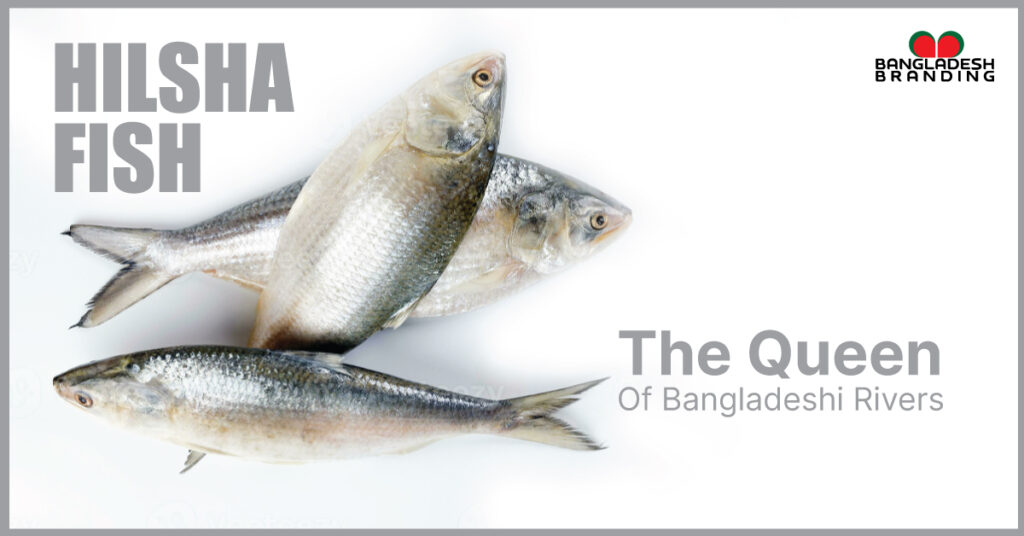Hilsa, often referred to as the “Queen of Rivers” in Bangladesh, is more than just a fish; it’s a cultural icon. This migratory fish with a silvery look has been a staple of Bangladeshi cuisine for ages. It is a highly prized delicacy both domestically and internationally because of its unique flavour, texture, and nutritional value.
Why is Hilsa Special?
- Geographical Indication (GI) Tag: The World Intellectual Property Organization (WIPO) has granted Hilsa a Geographical Indication (GI) tag. The recognition provided by this indicates a strong correlation between the fish’s unique traits and its Bangladeshi heritage. Rivers, estuaries, and coastal environments are examples of specific geographic elements that affect the distinctive flavour and characteristics of this product.
- Nutritional Value: Hilsa is a great source of protein, important vitamins and minerals, and omega-3 fatty acids. These nutrients are necessary for overall health, heart health, and brain function.
- Cultural Significance: Hilsa is very important to Bangladeshi culture, even outside of its culinary significance. It is commonly linked to celebrations, holidays, and significant occurrences. An eagerly anticipated yearly event, the arrival of hilsa from the sea heralds the start of the fishing season.

How to Enjoy Hilsa?
Hilsa can be prepared in various ways, but some of the most popular methods include:
- Hilsa Bhaja: This classic dish involves frying the whole fish until crispy and golden brown.
- Hilsa Paturi: The fish is wrapped in banana leaves with a spicy paste and steamed, resulting in a tender and flavorful delicacy.
- Hilsa Kalia: A curry made with hilsa, often cooked with mustard oil, onions, tomatoes, and a blend of spices.

Conservation Efforts
The Bangladeshi government has implemented a number of conservation measures to ensure the hilsa population’s long-term viability. These include enforcing fishing laws, safeguarding spawning sites, and encouraging environmentally friendly aquaculture. Bangladesh wants to ensure that future generations will benefit from this priceless resource, hence it is working to preserve the hilsa fisheries.
The GI-tagged hilsa fish represents Bangladesh’s rich culinary heritage and commitment to sustainable food production. For foodies and visitors alike, its unique flavour, nutritional benefits, and cultural significance make it a must-try.
When to Catch Hilsa: A Seasonal Delight
The monsoon season, which in Bangladesh usually lasts from June to September, is the ideal time of year to catch hilsa fish. At this time, fish move to freshwater rivers from the sea to spawn. It’s crucial to remember that the precise time can change slightly based on the environment, including the weather.
Why Monsoon Season is Ideal?
- Plenty of Supply: When hilsa fish enter rivers in large quantities during the monsoon, fishermen find it easier to catch them.
- Optimal Flavor: Because of their diet and reproductive cycle, fish caught during this period are thought to have the best flavor and texture.
Fishing Restrictions
The Bangladeshi government has put in place certain fishing restrictions in order to guarantee the long-term viability of the hilsa population. These could consist of:
- Size Restrictions: The minimum and maximum sizes of hilsa fish that can be captured may apply.
- Restrictions on Gear: Some fishing gear, like explosives or gillnets, may not be allowed.
- Closed Seasons: To give the fish time to spawn, fishing for hilsa may be entirely prohibited during certain times.
Adherence to these regulations is imperative in order to safeguard the hilsa fishery and guarantee its continued existence. You can help conserve this tasty and culturally significant fish while also enjoying it if you abide by these rules.

